How Did The Use Of Iron Affect Medieval Farming
Loading...
Medieval farming could be summarized as endless work. For a serf on an estate, there was always something that needed doing. Sloth was not tolerated considering if the harvest failed, the whole village could confront starvation in the winter.
That is not to say that the tasks were monotonous. Medieval farming followed a bicycle throughout the yr.
Repairing
Peasants had to make their own houses during the Medieval Menses. They used mud and sticks for the flooring and walls and the roof was thatched with harbinger.
Bad weather and high winds would hands damage the houses and it was essential that repairs were carried out as soon equally possible. However, because of the vast number of jobs that needed to be washed throughout the twelvemonth, information technology was oft simply in the Winter months that the peasants would have time to practise proper repairs, the rest of the twelvemonth they would simply patch their houses upward.y good it would be difficult to find straw needed.
Wood and twigs were used to make repairs to the walls of the peasant's houses. They were woven together to make them as strong as possible. The roofs were thatched with straw so if the harvest was not very good information technology would be difficult to find straw needed.
Planting
During the late winter and early leap, vegetables were planted in the peasants' gardens. Later in the year, in Apr and May, new fruit copse might be planted in the orchard.
Peas, beans and onions were grown in the peasants' gardens (tofts). These vegetables were used to make a thick blazon of stew chosen pottage.
Apple and pear trees were planted in the orchard or in the peasants' ain gardens to provide fruit.
Berry bushes were sometimes besides planted to ensure a supply of berries.
Weaving
Weaving was one of the main Medieval means of making things. Twigs were woven together to make fences and house walls or baskets and thread was woven into material.
Baskets were often woven out of willow. Willow rods know equally 'withies' were harvested during the winter months when the leaves had dropped.

The kickoff stage is to weave the base of the handbasket. Next the upright withies are put in identify. Finally withies are woven in and out of the uprights to make the basket.
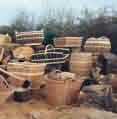
The willow can likewise be dyed using natural products such as berries or vegetables.

The wool taken from sheep during shearing was used to brand clothes. The start stage was to card the wool to remove whatsoever tangles. Later on that information technology had to be spun to brand information technology into thread.
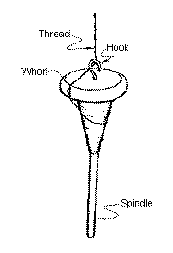
Before the invention of the spinning bike in the 15th Century, wool had to exist spun using a drib spindle.
Wool fibres are twisted into thread with one hand and fed onto the spindle where it is wound into one long thread ready to utilise for weaving cloth.
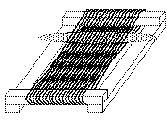
When the wool had been spun it was so ready to be woven into cloth. A loom was used to hold the threads in place.
Ploughing
Before the seeds could be planted, land had to exist ploughed. Ploughs were shared by the villagers and were pulled by teams of oxen.
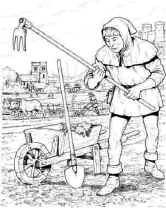
The fields were ploughed in the early spring and as well in the Fall after the harvest had been gathered in. The village turn or ploughs were often kept in the church.
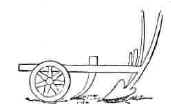
As the plough is pulled across the field, the two metal projections dig into the soil and break information technology upwards gear up for planting.
Fertilising
In guild to ensure a good harvest and a good ingather of vegetables, it was necessary to fertilise the soil earlier the seeds were sown.
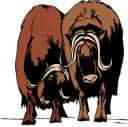
Equus caballus, oxen and pig droppings were collected throughout the year so that there was enough to dig into the fields before the seeds were sown and vegetables planted.
Sometimes, human droppings would also exist used.
Sowing
The sowing of seeds was some other important job that had to be done during the Medieval farming twelvemonth.
Once the fields had been ploughed, seeds had to be scattered into the earth. It was important to spread the seeds evenly so that there was a skilful crop.
There were no machines to practise this job so it had to be done by hand.
Weeding
As shortly as the new seedlings started to grow, weeding was a full-time job. Children, men and women all helped with the weeding.
It was very of import to remove weeds from the soil as soon as possible.
Weeds take moisture and goodness from the soil that is needed for the crops if they are to grow into a good harvest.
If the weeds are immune to grow taller than the crops they will forestall low-cal from getting to the seedlings.
Pruning
The apple and pear trees that were grown in the orchard had to exist pruned each yr.
Pruning a fruit tree means cutting abroad some of the tree's branches to encourage it to grow more than quickly and produce more than fruit.
However, pruning needs to be done carefully because cut too much, or non enough, away tin event in either a poor crop or no fruit at all.
Young copse are pruned in Apr or May, merely large, well established trees tin can be pruned in the winter time when the tree is dormant (not growing).
Scaring the Birds
Once the seeds had been sown it was very important to make sure that birds did not swallow all the seeds.

This boy is using a pulsate to make a racket to scare birds away from the fields
Children every bit young as 3 or 4 would be sent out into the fields. Their job was to run, shout and clap their hands to scare the birds away.
Drums, bells and sticks would also exist used to brand a noise that would scare the birds.
Shearing
In June, the sheep that were kept on the common land, were shorn for their wool. There were many more than sheep than people in England in the Middle Ages and wool was the most commonly used material for article of clothing.
Wool was sold at market place to merchants who would send English woollen cloth to other European countries.
Considering sheep were so important for their wool, it was important to make certain that they were protected from predators such as wolves and dogs.
The task of shepherd would be given to someone who was unable to do hard physical labour.
Harvesting
There were two harvests during the Medieval farming year. The first was the hay harvest during June. However the main, and busiest, event of the farming agenda was the wheat harvest that took identify at the terminate of the summer during August and September. The Lord of the Manor would often provide food and drink for the peasants to take a festival once the harvest was gathered in.
Harvest Festival, likewise known equally 'Harvest Home' is still celebrated today. Everyone had to work long hours during harvest time – from the time that the sun rose in the morning until night. Men, women and children all worked together to make certain that the harvest was gathered in.
If the harvest was non finished on fourth dimension so the wheat would be destroyed by the common cold and pelting and the village was likely to fact starvation.

This picture shows a woman cutting wheat using a scythe
There were no machines in the Heart Ages and harvesting had to be done by mitt using a scythe. Information technology was back breaking work as the peasants were bent double from morning to dark, frequently with only a very brusk break for luncheon.
Collecting and Gathering
Collecting was an all-yr activeness. Baskets woven during the Autumn and Wintertime months were used to collect fresh eggs from the peasants ain chickens.
The baskets were as well used during the tardily Summertime and Autumn to collect berries from the hedgerows and fruit from the trees planted in the orchard.
Forest for fires had to exist collected throughout the yr to make sure that a skilful stock was built up before the cold wintertime months. The children would be sent to the forest to collect twigs and branches, while the men would utilize axes to chop downward trees for wood.
Some of the wood might be used to repair their houses.
Tying
As the wheat was harvested it had to be tied into sheaves to dry. This chore was oftentimes done past women. The sheaves of wheat would then be transported, by equus caballus drawn cart, to a befouled for storage.

During harvest time the fields would be total of sheaves of wheat waiting to be transported to the befouled for storage.
The carts of wheat were pulled by horses or oxen. This could exist a dangerous activeness for the driver of the cart because carts were piled loftier with sheaves of wheat and often toppled over.

Winnowing

Winnowing is the proper name given to the process of separating the grain from the chaff (outer casing). Nevertheless, before winnowing could accept place the wheat had to be threshed (beaten) to carve up the grain from the stalk.

A sieve was often used to separate the grain from the chaff. The wheat heads were put into the sieve and were so either shaken from side to side or tossed into the air. The crust would then be blown away by the breeze or, if in that location was no current of air, past another person wafting a sheet.
In one case the grain had been separated it could so be milled into flour which was used to make bread.
Milling
Milling is the name given to the process where grain is turned into flour. In the earliest times this had to be done by manus using a mortar and pestle to grind the grain into flour. However, past the Medieval catamenia, near towns and villages had a mill.
The cogs that turned the grindstones were initially powered by animals, but during the Medieval menstruum, animate being ability was replaced by either current of air or water power.
The showtime record of a windmill in England is a manufacturing plant in Yorkshire that dated from 1185.
The mill was owned by the lord of the manor and it was his responsibleness to brand sure that there were enough mills to grind sufficient grain for all his people. The lord also had a say in who used the mill and when and it was forbidden to use any other mill. The lord also charged a fee for the use of his manufactory.
In the twelfth century, Pope Celestine III stated that the air used by windmills was owned by the church and and then a taxation must be paid to the church for their utilise.
Watermills were more reliable than windmills because they did not depend on the atmospheric condition.
Still, watermills had to built next to a stream with running h2o if they were to operate.

A watermill is called a watermill considering it is powered by water.
Butchering
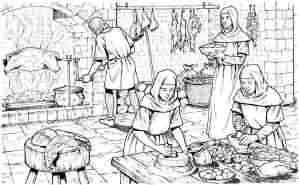
In Nov and December some of the animals had to be butchered to provide meat to swallow through the winter. It was also necessary to table salt or smoke some of the meat to make certain that it lasted through the wintertime.
Peasants had to impale their own animals.
Some of the meat would be roasted over a spit and some of it would be preserved for apply during the winter months past salting or smoking it.
Information technology was essential that there was a adept supply of meat for the wintertime as there were no vegetables or fruits bachelor.
Salting and Smoking
Information technology was necessary to table salt or smoke some of the meat that was butchered during November and December to make certain that it lasted through the winter.

Table salt in rock class
Some of the meat would exist salted to preserve it through the winter. However, salt was very expensive and it was unlikely that the peasants would have had access to much of information technology.
In Roman times salt had been used as coin and the English word salary comes from the latin word for salt.
It was more usual that the peasants would smoke meat to preserve it through the winter.

Peasants lived in one roomed houses and the burn down was in the centre of the room. Consequently the room became smoky when the burn was lit. Meat could therefore exist smoked by hanging information technology from the rafters in the roof.
Excavation
There were a multifariousness of excavation activities that had to exist carried out during the Medieval period:
Drainage ditches had to exist dug to prevent damage to crops by flooding.
Peasants too had to dig their own gardens (tofts) before they could plant vegetables, and if they were not able to rent or infringe a plough they would also have to dig their fields (crofts).

A scythe and hoe of the type used during the Medieval period.
All tools made during the Medieval menses would be made by the blacksmith.
Garden and farming tools would be fabricated from wood and iron.
This commodity is office of our larger choice of posts nearly the medieval period. To larn more, click here for our comprehensive guide to the Middle Ages.
Cite This Commodity
"Medieval Farming and the Farming Year" History on the Net
© 2000-2022, Salem Media.
July 17, 2022 <https://world wide web.historyonthenet.com/medieval-farming-the-farming-year>
More Citation Information.
How Did The Use Of Iron Affect Medieval Farming,
Source: https://www.historyonthenet.com/medieval-farming-the-farming-year
Posted by: walkerdeboyfaing.blogspot.com


0 Response to "How Did The Use Of Iron Affect Medieval Farming"
Post a Comment